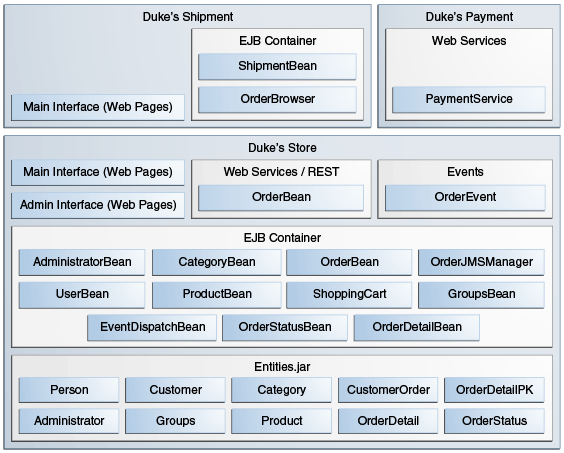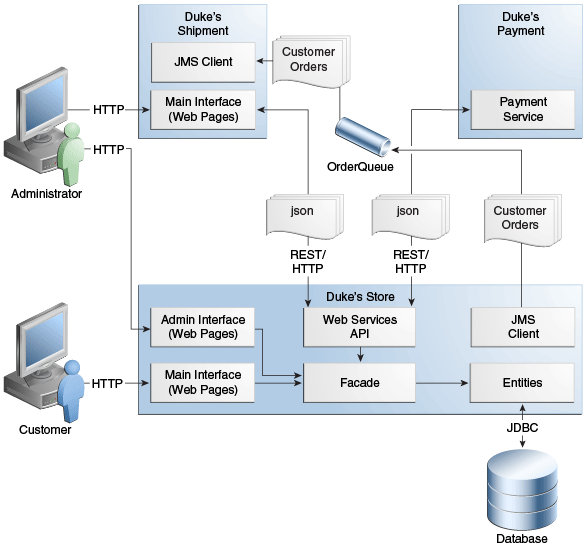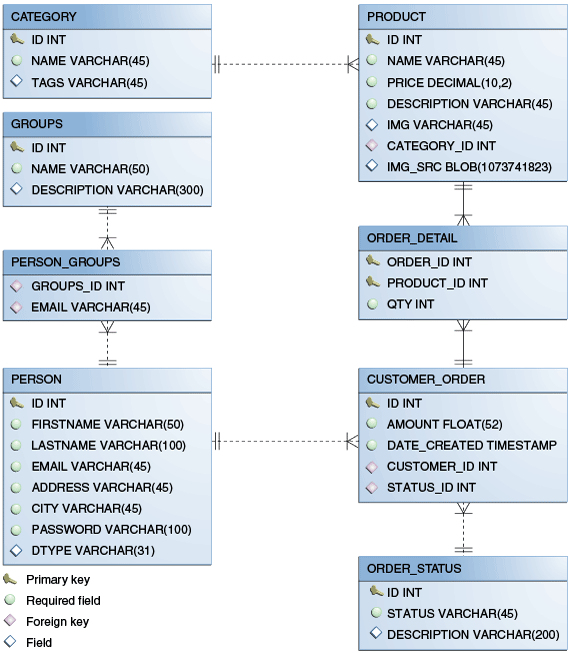Design and Architecture of Duke's Forest (original) (raw)
Duke’s Forest is a complex application consisting of three main projects and three subprojects. Figure 62-1 shows the architecture of the three main projects that you will deploy: Duke’s Store, Duke’s Shipment, and Duke’s Payment. It also shows how Duke’s Store makes use of the Events and Entities projects.
Figure 62-1 Architecture of the Duke’s Forest Example Application

Duke’s Forest uses the following Java EE platform features:
- Java Persistence API entities
- Bean Validation annotations on the entities for verifying data
- XML annotations for Java API for XML binding (JAXB) serialization
- Web services
- A JAX-RS web service for payment, with security constraints
- A JAX-RS web service that is EJB based
- Enterprise beans
- Local session beans
- All enterprise beans packaged within the WAR
- Contexts and Dependency Injection (CDI)
- CDI annotations for JavaServer Faces components
- A CDI managed bean used as a shopping cart, with conversation scoping
- Qualifiers
- Events and event handlers
- Servlets
- A servlet for dynamic image presentation
- JavaServer Faces technology, using Facelets for the web front end
- Templating
- Composite components
- File upload
- Resources packaged in a JAR file so they can be found in the classpath
- Security
- Java EE security constraints on the administrative interface business methods (enterprise beans)
- Security constraints for customers and administrators (web components)
- Single Sign-On (SSO) to propagate an authenticated user identity from Duke’s Store to Duke’s Shipment
The Duke’s Forest application has two main user interfaces, both packaged within the Duke’s Store WAR file:
- The main interface, for customers and guests
- The administrative interface used to perform back office operations, such as adding new items to the catalog
The Duke’s Shipment application also has a user interface, accessible to administrators.
Figure 62-2 shows how the web applications and the web service interact.
Figure 62-2 Interactions between Duke’s Forest Components

As illustrated in Figure 62-2, the customer interacts with the main interface of Duke’s Store, while the administrator interacts with the administration interface. Both interfaces access a façade consisting of managed beans and stateless session beans, which in turn interact with the entities that represent database tables. The façade also interacts with web services APIs that access the Duke’s Payment web service. When the payment for an order is approved, Duke’s Store sends the order to a JMS queue. The administrator also interacts with the interface of Duke’s Shipment, which can be accessed either directly through Duke’s Shipment or from the administration interface of Duke’s Store by means of a web service. When the administrator approves an order for shipping, Duke’s Shipment consumes the order from the JMS queue.
The most fundamental building blocks of the application are the Events and Entities projects, which are bundled into Duke’s Store and Duke’s Shipment along with the Duke’s Resources project.
The events Project
Events are one of the core components of Duke’s Forest. The eventsproject, included in all three of the main projects, is the most simple project of the application. It has only one class, OrderEvent, but this class is responsible for most of the messages between objects in the application.
The application can send messages based on events to different components and react to them based on the qualification of the event. The application supports the following qualifiers:
@LoggedIn: For authenticated users@New: When a new order is created by the shopping cart@Paid: When an order is paid for and ready for shipment
The following code snippet from the PaymentHandler class of Duke’s Store shows how the @Paid event is handled:
@Inject @Paid Event<OrderEvent> eventManager;
...
public void onNewOrder(@Observes @New OrderEvent event) {
if (processPayment(event)) {
orderBean.setOrderStatus(event.getOrderID(),
String.valueOf(OrderBean.Status.PENDING_PAYMENT.getStatus()));
logger.info("Payment Approved");
eventManager.fire(event);
} else {
orderBean.setOrderStatus(event.getOrderID(),
String.valueOf(OrderBean.Status.CANCELLED_PAYMENT.getStatus()));
logger.info("Payment Denied");
}
}To enable users to add more events to the project easily or update an event class with more fields for a new client, this component is a separate project within the application.
The entities Project
The entities project is a Java Persistence API (JPA) project used by both Duke’s Store and Duke’s Shipment. It is generated from the database schema shown in Figure 62-3 and is also used as a base for the entities consumed and produced by the web services through JAXB. Each entity has validation rules based on business requirements, specified using Bean Validation.
Figure 62-3 Duke’s Forest Database Tables and Their Relationships

The database schema contains eight tables:
PERSON, which has a one-to-many relationship withPERSON_GROUPSandCUSTOMER_ORDERGROUPS, which has a one-to-many relationship withPERSON_GROUPSPERSON_GROUPS, which has a many-to-one relationship withPERSONandGROUPS(it is the join table between those two tables)PRODUCT, which has a many-to-one relationship withCATEGORYand a one-to-many relationship withORDER_DETAILCATEGORY, which has a one-to-many relationship withPRODUCTCUSTOMER_ORDER, which has a one-to-many relationship withORDER_DETAILand a many-to-one relationship withPERSONandORDER_STATUSORDER_DETAIL, which has a many-to-one relationship withPRODUCTandCUSTOMER_ORDER(it is the join table between those two tables)ORDER_STATUS, which has a one-to-many relationship withCUSTOMER_ORDER
The entity classes that correspond to these tables are as follows.
Person, which defines attributes common to customers and administrators. These attributes are the person’s name and contact information, including street and email addresses. The email address has a Bean Validation annotation to ensure that the submitted data is well-formed. The generated table for thePersonentity also has aDTYPEfield that represents the discriminator column. Its value identifies the subclass (CustomerorAdministrator) to which the person belongs.Customer, a specialization ofPersonwith a specific field forCustomerOrderobjects.Administrator, a specialization ofPersonwith fields for administration privileges.Groups, which represents the group (USERSorADMINS) to which the user belongs.Product, which defines attributes for products. These attributes include name, price, description, associated image, and category.Category, which defines attributes for product categories. These attributes include a name and a set of tags.CustomerOrder, which defines attributes for orders placed by customers. These attributes include an amount and a date, along with id values for the customer and the order detail.OrderDetail, which defines attributes for the order detail. These attributes include a quantity and id values for the product and the customer.OrderStatus, which defines a status attribute for each order.
The dukes-payment Project
The dukes-payment project is a web project that holds a simple Payment web service. Since this is an example application, it does not obtain any real credit information or even customer status to validate the payment. For now, the only rule imposed by the payment system is to deny all orders above $1,000. This application illustrates a common scenario where a third-party payment service is used to validate credit cards or bank payments.
The project uses HTTP Basic Authentication and JAAS (Java Authentication and Authorization Service) to authenticate a customer to a JAX-RS web service. The implementation itself exposes a simple method,processPayment, which receives an OrderEvent to evaluate and approve or deny the order payment. The method is called from the checkout process of Duke’s Store.
The dukes-resources Project
The dukes-resources project contains a number of files used by both Duke’s Store and Duke’s Shipment, bundled into a JAR file placed in the classpath. The resources are in the src/main/resources directory:
META-INF/resources/css: Two style sheets,default.cssandjsfcrud.cssMETA-INF/resources/img: Images used by the projectsMETA-INF/resources/js: A JavaScript file,util.jsMETA-INF/resources/util: Composite components used by the projectsbundles/Bundle.properties: Application messages in Englishbundles/Bundle_es.properties: Application messages in SpanishValidationMessages.properties: Bean Validation messages in EnglishValidationMessages_es.properties: Bean Validation messages in Spanish
The Duke’s Store Project
Duke’s Store, a web application, is the core application of Duke’s Forest. It is responsible for the main store interface for customers as well as the administration interface.
The main interface of Duke’s Store allows the user to perform the following tasks:
- Browsing the product catalog
- Signing up as a new customer
- Adding products to the shopping cart
- Checking out
- Viewing order status
The administration interface of Duke’s Store allows administrators to perform the following tasks:
- Product maintenance (create, edit, update, delete)
- Category maintenance (create, edit, update, delete)
- Customer maintenance (create, edit, update, delete)
- Group maintenance (create, edit, update, delete)
The project also uses stateless session beans as façades for interactions with the JPA entities described in The entities Project, and CDI managed beans as controllers for interactions with Facelets pages. The project thus follows the MVC (Model-View-Controller) pattern and applies the same pattern to all entities and pages, as in the following example.
AbstractFacadeis an abstract class that receives aType<T>and implements the common operations (CRUD) for this type, where<T>is a JPA entity.ProductBeanis a stateless session bean that extendsAbstractFacade, applyingProductasType<T>, and injects thePersistenceContextfor theEntityManager. This bean implements any custom methods needed to interact with theProductentity or to call a custom query.ProductControlleris a CDI managed bean that interacts with the necessary enterprise beans and Facelets pages to control the way the data will be displayed.
ProductBean begins as follows:
@Stateless
public class ProductBean extends AbstractFacade<Product> {
private static final Logger logger =
Logger.getLogger(ProductBean.class.getCanonicalName());
@PersistenceContext(unitName="forestPU")
private EntityManager em;
@Override
protected EntityManager getEntityManager() {
return em;
}
...Enterprise Beans Used in Duke’s Store
The enterprise beans used in Duke’s Store provide the business logic for the application and are located in the com.forest.ejb package. All are stateless session beans.
AbstractFacade is not an enterprise bean but an abstract class that implements common operations for Type<T>, where <T> is a JPA entity.
Most of the other beans extend AbstractFacade, inject thePersistenceContext, and implement any needed custom methods:
AdministratorBeanCategoryBeanEventDispatcherBeanGroupsBeanOrderBeanOrderDetailBeanOrderJMSManagerOrderStatusBeanProductBeanShoppingCartUserBean
The ShoppingCart class, although it is in the ejb package, is a CDI managed bean with conversation scope, which means that the request information will persist across multiple requests. Also, ShoppingCartis responsible for starting the event chain for customer orders, which invokes the RESTful web service in dukes-payment and publishes an order to the JMS queue for shipping approval if the payment is successful.
Facelets Files Used in the Main Interface of Duke’s Store
Like the other case study examples, Duke’s Store uses Facelets to display the user interface. The main interface uses a large number of Facelets pages to display different areas. The pages are grouped into directories based on which module they handle.
template.xhtml: Template file, used for both main and administration interfaces. It first performs a browser check to verify that the user’s browser supports HTML 5, which is required for Duke’s Forest. It divides the screen into several areas and specifies the client page for each area.topbar.xhtml: Page for the login area at the top of the screen.top.xhtml: Page for the title area.left.xhtml: Page for the left sidebar.index.xhtml: Page for the main screen content.login.xhtml: Login page specified inweb.xml. The main login interface is provided intopbar.xhtml, but this page appears if there is a login error.admindirectory: Pages related to the administration interface, described in Facelets Files Used in the Administration Interface of Duke’s Store.customerdirectory: Pages related to customers (Create.xhtml,Edit.xhtml,List.xhtml,Profile.xhtml,View.xhtml).orderdirectory: Pages related to orders (Create.xhtml,List.xhtml,MyOrders.xhtml,View.xhtml).orderDetaildirectory: Popup page allowing users to view details of an order (View_popup.xhtml).productdirectory: Pages related to products (List.xhtml,ListCategory.xhtml,View.xhtml).
Facelets Files Used in the Administration Interface of Duke’s Store
The Facelets pages for the administration interface of Duke’s Store are found in the web/admin directory:
administratordirectory: Pages related to administrator management (Create.xhtml,Edit.xhtml,List.xhtm`l, `View.xhtml)categorydirectory: Pages related to product category management (Create.xhtml,Edit.xhtml,List.xhtml,View.xhtml)customerdirectory: Pages related to customer management (Create.xhtml,Edit.xhtml,List.xhtml,Profile.xhtml,View.xhtml)groupsdirectory: Pages related to group management (Create.xhtml,Edit.xhtml,List.xhtml,View.xhtml)orderdirectory: Pages related to order management (Create.xhtml,Edit.xhtml,List.xhtml,View.xhtml)orderDetaildirectory: Popup page allowing the administrator to view details of an order (View_popup.xhtml)productdirectory: Pages related to product management (Confirm.xhtm`l, `Create.xhtml,Edit.xhtml,List.xhtml,View.xhtml)
Managed Beans Used in Duke’s Store
Duke’s Store uses the following CDI managed beans, which correspond to the enterprise beans. The beans are in the com.forest.web package:
AdministratorControllerCategoryControllerCustomerControllerCustomerOrderControllerGroupsControllerOrderDetailControllerOrderStatusControllerProductControllerUserController
Helper Classes Used in Duke’s Store
The CDI managed beans in the main interface of Duke’s Store use the following helper classes, found in the com.forest.web.util package:
AbstractPaginationHelper: An abstract class with methods used by the managed beansImageServlet: A servlet class that retrieves the image content from the database and displays itJsfUtil: Class used for JavaServer Faces operations, such as queuing messages on aFacesContextinstanceMD5Util: Class used by theCustomerControllermanaged bean to generate an encrypted password for a user
Qualifiers Used in Duke’s Store
Duke’s Store defines the following qualifiers in thecom.forest.qualifiers package:
@LoggedIn: Qualifies a user as having logged in@New: Qualifies an order as new@Paid: Qualifies an order as paid
Event Handlers Used in Duke’s Store
Duke’s Store defines event handlers related to the OrderEvent class packaged in the events project (see The events Project). The event handlers are in the com.forest.handlers package.
IOrderHandler: TheIOrderHandlerinterface defines a method,onNewOrder, implemented by the two handler classes.PaymentHandler: TheShoppingCartbean fires anOrderEventqualified as@New. TheonNewOrdermethod ofPaymentHandlerobserves these events and, when it intercepts them, processes the payment using the Duke’s Payment web service. After a successful response from the web service,PaymentHandlerfires theOrderEventagain, this time qualified as@Paid.DeliveryHandler: TheonNewOrdermethod ofDeliveryHandlerobservesOrderEventobjects qualified as@Paid(orders paid and ready for delivery) and modifies the order status toPENDING_SHIPMENT. When an administrator accesses Duke’s Shipment, it will call the Order Service, a RESTful web service, and ask for all orders in the database that are ready for delivery.
Deployment Descriptors Used in Duke’s Store
Duke’s Store uses the following deployment descriptors, located in theweb/WEB-INF directory:
faces-config.xml: The JavaServer Faces configuration fileglassfish-web.xml: The configuration file specific to GlassFish Serverweb.xml: The web application configuration file
The Duke’s Shipment Project
Duke’s Shipment is a web application with a login page, a main Facelets page, and some other objects. This application, which is accessible only to administrators, consumes orders from a JMS queue and calls the RESTful web service exposed by Duke’s Store to update the order status. The main page of Duke’s Shipment shows a list of orders pending shipping approval and a list of shipped orders. The administrator can approve or deny orders for shipping. If approved, the order is shipped, and it appears under the Shipped heading. If denied, the order disappears from the page, and on the customer’s Orders list it appears as cancelled.
There is also a gear icon on the Pending list that makes an Ajax call to the Order Service to refresh the list without refreshing the page. The code looks like this:
<h:commandLink>
<h:graphicImage library="img" title="Check for new orders"
style="border:0px" name="refresh.png"/>
<f:ajax execute="@form" render="@form" />
</h:commandLink>Enterprise Beans Used in Duke’s Shipment
The UserBean stateless session bean used in Duke’s Shipment provides the business logic for the application and is located in thecom.forest.shipment.session package.
Like Duke’s Store, Duke’s Shipment uses the AbstractFacade class. This class is not an enterprise bean but an abstract class that implements common operations for Type<T>, where <T> is a JPA entity.
The OrderBrowser stateless session bean, located in thecom.forest.shipment.ejb package, has one method that browses the JMS order queue and another that consumes an order message after the administrator approves or denies the order for shipment.
Facelets Files Used in Duke’s Shipment
Duke’s Shipment has only one page, so it has many fewer Facelets files than Duke’s Store.
template.xhtml: The template file, like the one in Duke’s Store, first performs a browser check to verify that the user’s browser supports HTML 5, which is required for Duke’s Forest. It divides the screen into areas and specifies the client page for each area.topbar.xhtml: Page for the login area at the top of the screen.top.xhtml: Page for the title area.index.xhtml: Page for the initial main screen content.login.xhtml: Login page specified inweb.xml. The main login interface is provided intopbar.xhtml, but this page appears if there is a login error.admin/index.xhtml: Page for the main screen content after authentication.
Managed Beans Used in Duke’s Shipment
Duke’s Shipment uses the following CDI managed beans, in thecom.forest.shipment package:
web.ShippingBean: Managed bean that acts as a client to the Order Serviceweb.UserController: Managed bean that corresponds to theUserBeansession bean
Helper Class Used in Duke’s Shipment
The Duke’s Shipment managed beans use only one helper class, found in the com.forest.shipment.web.util package:
JsfUtil: Class used for JavaServer Faces operations, such as queuing messages on aFacesContextinstance
Qualifier Used in Duke’s Shipment
Duke’s Shipment includes the @LoggedIn qualifier described inQualifiers Used in Duke’s Store.
Deployment Descriptors Used in Duke’s Shipment
Duke’s Shipment uses the following deployment descriptors:
faces-config.xml: The JavaServer Faces configuration fileglassfish-web.xml: The configuration file specific to GlassFish Serverweb.xml: The web application configuration file